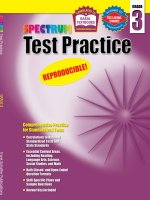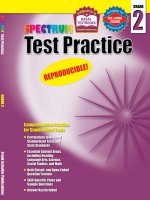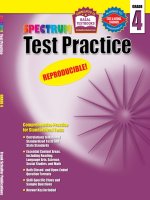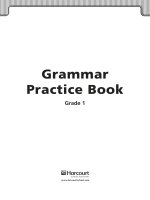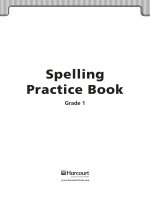Fresh reads for differentiated test practice grade 1 TM 187p
Bạn đang xem bản rút gọn của tài liệu. Xem và tải ngay bản đầy đủ của tài liệu tại đây (4.42 MB, 187 trang )
NOTES TO THE TEACHER
Introduction
Fresh Reads for Differentiated Test Practice is designed to provide
differentiated practice in reading comprehension skills and to prepare children
to take the Reading/Language Arts section of standardized tests, state tests,
or teacher-made tests. The student book includes the weekly differentiated
practice tests to strengthen comprehension skills taught in Scott Foresman
Reading Street. This Teacher’s Manual includes the following: (1) notes on
how to use the Fresh Read tests, (2) instructions on how to administer and
score a fluency test, (3) a chart on which you may record the progress of your
children, and (4) annotated copies of all of the Fresh Read tests indicating the
correct answer to all questions.
How to Use the Fresh Read Tests
The purpose of the Fresh Read tests is to give weekly differentiated practice in
target comprehension skills taught in Scott Foresman Reading Street.
This book contains three Fresh Read tests for each week to be used
independently from the main selection in Scott Foresman Reading Street. The
tests consist of a “Fresh Read” leveled passage (or a drawing) and related
comprehension items that focus on the target and review comprehension skills
of the week but are written to address varying levels of proficiency—Strategic
Intervention (SI), On-Level (OL), and Advanced (A). A code at the bottom of
each page tells you the level of each test. Drawings are used instead of written
passages in Unit 1 for the SI and OL tests, and in Unit 2 for the SI tests. In
Unit 1 all test questions are intended to be read aloud to the children for all
three levels of the tests. In Unit 2 the test questions are to be read aloud to the
children only for the SI and OL tests. You may choose whether or not to read
these and other tests aloud, based on your knowledge of your class.
© Pearson Education 1
You can assess children’s proficiency levels using their responses to oral
comprehension questions and their work on the comprehension pages in the
Practice Book or Teacher’s Resource Book. Fresh Read tests can be done
independently, or you may choose to work through them with children in small
groups, in order to give support and assess children’s progress.
Fresh Reads
v
Other ways to use the Fresh Read test pages:
• use the Strategic Intervention pages for whole-class practice with the
comprehension skills and/or test-taking skills
• use the Strategic Intervention pages after introducing the target and review
comprehension skills but prior to reading the main selection in the student
anthology of Scott Foresman Reading Street to assess children’s readiness
to read that selection
• use the On-Level pages as an assessment tool to check children’s
understanding of the comprehension skills and/or test-taking skills
• use the On-Level pages to check children’s need for further practice,
reteaching, or more challenging materials
• use the Advanced pages as a substitute for the comprehension pages in
the Practice Book or Teacher’s Resource Book for children working above
grade level
© Pearson Education 1
• use any of the pages as preparation for the unit Benchmark Test
vi
Fresh Reads
How to Administer and Score a Fluency Test
A fluency test measures a child’s reading rate, or the number of words
correctly read per minute (wcpm), on grade-level text the child has not seen
before. You may want to use a copy of one of the “On-Level” leveled passages
from the Fresh Read tests for this purpose. Make a photocopy for yourself of
the passage you will give the child. (Starting with Unit 3, the pages in this
Teacher’s Manual have a scale of running numbers to make it easier for you
to know how many words the child read during the fluency check, while the
passages in the student edition do not have the numbers.) Make sure you have
put the child’s name and the test date at the top of your copy of the passage.
Have a watch or clock with a second hand available for timing the reading.
Give the child a copy of the passage for the test. Note: The child should NOT
have seen the passage beforehand; it is a “fresh” reading passage for the child.
Do NOT allow the child to read the passage silently before oral reading.
Have the child read the text aloud. Do not have the child read the title as part
of the fluency reading; it is not included in the running word count. (You may
want to tape-record the child’s reading for later evaluation.) Stop the child at
exactly one minute and note precisely where the child stopped.
As the child reads orally, on your copy of the text mark any miscues or errors
the child makes during the reading (see the chart on page viii). Count the total
number of words the child read in one minute. Subtract any words the child
read incorrectly. Record the words correct per minute score on the test.
The formula is: Total # of words read – # of errors = words correct per minute
(wcpm).
© Pearson Education 1
You will likely want to keep the test in your folder for the child. You may also
want to record children’s progress on the Reading Fluency Progress Chart on
page xi.
Fresh Reads
vii
How to Identify Reading Miscues/Errors
Using the passage on page ix, the chart below shows the kinds of miscues and
errors to look for as a child reads aloud and the notations to use to mark them.
Reading Miscue
Notations
Omission
Some days are so cold!
The child omits words or word parts.
Substitution
The child substitutes words or parts
of words for the words in the text.
Bears go to caves to sleep.
Insertion
The child inserts words or parts of
words that are not in the text.
Small children like to run in the cold.
Mispronunciation/Misreading
The child pronounces or reads a
word incorrectly.
Cold winds come.
Hesitation
The child hesitates over a word and
the teacher provides the word.
Children have mittens and hats so
they can play outside.
Self-correction
The child reads a word incorrectly
but then corrects the error.
Big children like to skate on the ice.
and
out
Came
H
sc
Notes
• If the child hesitates over a word, wait several seconds before telling the
child what the word is.
• If a child makes the same error more than once, count it as only one error.
© Pearson Education 1
• Self-correction is not counted as an actual error. However, writing “SC”
over the word or words will help you identify words that give the child
some difficulty.
viii
Fresh Reads
Interpreting the Results
According to published norms for oral reading fluency, children at the end of
Grade 1 should be reading fluently at 60 words correct per minute in text that
is on grade level. This chart gives recommended progress toward that goal.
End of Unit/Grade
Reading Rate (wcpm)
Grade 1
Unit 1
N/A
Grade 1
Unit 2
N/A
Grade 1
Unit 3
Grade 1
Grade 1
Unit 4
Unit 5
End of Year Goal
Weeks 1-3
20 to 30
Weeks 4-6
25 to 35
Weeks 1-3
30 to 40
Weeks 4-6
35 to 45
Weeks 1-3
40 to 52
Weeks 4-6
45 to 60
60
© Pearson Education 1
If a child’s reading rate is lower than the suggested progress toward the
standard for his or her grade level, your notes on the child’s miscues may help
you determine why the rate is low. Does the child make errors that indicate his
or her decoding skills are poor? If so, further instruction in phonics may be
needed. Do the errors reflect a lack of comprehension or limited vocabulary?
In that case, instruction in comprehension strategies and exposure to more
vocabulary words may help. A lack of fluency may indicate a lack of exposure
to models of fluent oral reading. It may also mean that the child isn’t reading
enough material at his or her reading level. “Matching Students to Texts” in
the Additional Resources section at the back of the Scott Foresman Reading
Street Teacher’s Editions gives suggestions on increasing reading fluency.
x
Fresh Reads
Reading Fluency Progress Chart
Unit 1
Child’s Name
Date
WCPM
Unit 2
Date
WCPM
Unit 3
Date
WCPM
Unit 4
Date
WCPM
Unit 5
Date
WCPM
1.
2.
3.
4.
5.
6.
7.
8.
9.
10.
11.
12.
13.
14.
15.
16.
17.
18.
19.
20.
21.
22.
23.
24.
25.
© Pearson Education 1
26.
27.
28.
29.
30.
31.
32.
33.
34.
35.
Fresh Reads
xi
Sam, Come Back!
Name
Look at the pictures. Answer the questions that follow.
© Pearson Education 1
Jason Learns to Ride
Turn the page.
Fresh Reads
Unit 1 Week 1 SI
1
Answer the questions below.
1
What did Jason do first?
⅜ He rode his bike.
⅜ He put on his helmet.
⅜ He got help from Mom.
2
How did Jason feel before he rode his bike?
⅜ happy
⅜ sleepy
⅜ scared
3
How did Jason feel after he rode his bike?
⅜ happy
⅜ sad
⅜ angry
4
How does Jason feel about riding a bike?
© Pearson Education 1
He enjoys riding his bike.
2
Fresh Reads
Unit 1 Week 1 SI
Sam, Come Back!
Name
Look at the pictures. Answer the questions that follow.
The Playful Girl
1.
2.
© Pearson Education 1
3.
Turn the page.
Fresh Reads
Unit 1 Week 1 OL
3
1
What did the girl do first?
⅜ She watched the rain.
⅜ She played ball.
⅜ She rode her bike.
2
What does the girl like to do?
⅜ She likes to play.
⅜ She likes to sit.
⅜ She likes to read.
3
How does the girl feel when she plays?
⅜ sad
⅜ happy
⅜ tired
4
How does the girl feel when it rains?
⅜ happy
⅜ sleepy
⅜ sad
5
What does the girl like doing outside?
The girl likes to play ball. The
girl likes to ride her bike.
4
Fresh Reads
Unit 1 Week 1 OL
© Pearson Education 1
Answer the questions below.
Sam, Come Back!
Name
Read the selection. Answer the questions that follow.
Dan’s Cat
Dan has a little cat. The cat is Rags. Dad is mad at Rags.
Rags gets in Dad’s bag. Dad can see Dan and Rags play. Dan
and Rags play in the green grass. Then, Rags naps on Dan’s
lap. Dan pats Rags on the back. Rags is happy. Dan is glad to
© Pearson Education 1
have Rags as a pal.
Turn the page.
Fresh Reads
Unit 1 Week 1 A
5
1
Why is Dad mad?
⅜ Rags hurt Dad.
⅜ Rags gets in Dad’s bag.
⅜ Rags is lost.
2
How does Dan feel about Rags?
⅜ mad
⅜ sad
⅜ glad
3
What do Rags and Dan do just after they play?
⅜ Rags takes a nap.
⅜ Dad gets mad.
⅜ Dan pats Rags.
4
What does Dan do for Rags?
Answers may vary. Possible
response: Dan plays with and
cares for Rags.
5
How does Rags feel about Dan?
Rags likes Dan.
6
Fresh Reads
Unit 1 Week 1 A
© Pearson Education 1
Answer the questions below.
Pig in a Wig
Name
Look at the pictures. Answer the questions that follow.
The Lion and the Monkey
2.
3.
4.
© Pearson Education 1
1.
Turn the page.
Fresh Reads
Unit 1 Week 2 SI
7
Answer the questions below.
1
What can not really happen?
⅜ Trees grow in a forest.
⅜ Animals live in a forest.
⅜ Animals eat at a table.
2
The monkey was
⅜ kind to the lion.
⅜ mean to the lion.
⅜ afraid of the lion.
3
A real lion does not
⅜ eat.
⅜ wear clothes.
⅜ have fur.
4
What could really happen in this story?
© Pearson Education 1
A lion could be hungry and
need to eat.
8
Fresh Reads
Unit 1 Week 2 SI
Pig in a Wig
Name
Look at the picture. Answer the questions that follow.
© Pearson Education 1
Fun at the Beach
Turn the page.
Fresh Reads
Unit 1 Week 2 OL
9
1
How does the mouse feel?
⅜ happy
⅜ sad
⅜ hungry
2
How can you tell this is make-believe?
⅜ There is sand at the beach.
⅜ There are waves in the water.
⅜ A mouse uses a shovel.
3
What can really happen?
⅜ A pig reads.
⅜ A dog sleeps.
⅜ A fox uses a fork.
4
A real fox does not
⅜ eat.
⅜ have ears.
⅜ sit in a beach chair.
5
What can not really happen?
Answers may vary. Possible
response: Real animals do not
have picnics.
10
Fresh Reads
Unit 1 Week 2 OL
© Pearson Education 1
Answer the questions below.
Pig in a Wig
Name
Read the selection. Answer the questions that follow.
Max on a Trip
Dear Jack,
I was on a trip with my cat, Sam. I had my hat and a pack
on my back. Sam had his cap. We saw Tim. Tim was a big
green cat.
Tim said, “Come and play tag with me!”
We did. We had a snack and a nap. Then Sam and I ran
back.
From,
© Pearson Education 1
Max
Turn the page.
Fresh Reads
Unit 1 Week 2 A
11
Answer the questions below.
1
What can not really happen?
⅜ Max has a snack.
⅜ Max has a nap.
⅜ A cat talks to Max.
2
Max is
⅜ silly.
⅜ mean.
⅜ bad.
3
What can really happen?
⅜ A cat can talk.
⅜ A boy can have a hat.
⅜ A cat can have a cap.
4
What is something that Max really did?
5
How do you know this story is make-believe?
Answers may vary. Possible
response: Cats do not talk.
12
Fresh Reads
Unit 1 Week 2 A
© Pearson Education 1
Answers may vary. Possible
response: Max went on a trip.
The Big Blue Ox
Name
Look at the pictures. Answer the questions that follow.
© Pearson Education 1
Ling Plays Ball
Turn the page.
Fresh Reads
Unit 1 Week 3 SI
13
1
Ling likes to
⅜ play t-ball.
⅜ take walks.
⅜ cook.
2
Where does this story take place?
⅜ at Ling’s home
⅜ at a park
⅜ at a store
3
How did Ling feel when she hit the ball?
⅜ sad
⅜ angry
⅜ happy
4
How can you tell this story could really happen?
Answers may vary. Possible
response: A girl could play
t-ball.
14
Fresh Reads
Unit 1 Week 3 SI
© Pearson Education 1
Answer the questions below.
The Big Blue Ox
Name
Read the selection. Answer the questions that follow.
Fox’s Box
Fox got in the big box at the pond. The box left the dock. It
did not stop. Fox was not glad. He did not like to get wet. He
had to get back to land.
“Help!” Fox said.
“Hop in the pond!” said Fish. “You can do it! Come with
me!”
© Pearson Education 1
Fox did it, and he got back to land.
Turn the page.
Fresh Reads
Unit 1 Week 3 A
17
Answer the questions below.
1
Where was Fox?
⅜ on a hill
⅜ at a pond
⅜ at his house
2
How did Fox feel when the box went in the pond?
⅜ funny
⅜ happy
⅜ scared
3
Fish likes to
⅜ help.
⅜ run.
⅜ sit.
4
How did Fox feel at the end of the story?
5
How do you know this story is make-believe?
Foxes and fish can not talk.
18
Fresh Reads
Unit 1 Week 3 A
© Pearson Education 1
Fox was happy.
The Big Blue Ox
Name
Look at the picture. Answer the questions that follow.
© Pearson Education 1
On a Trip
Turn the page.
Fresh Reads
Unit 1 Week 3 OL
15
1
The boy and the dog are
⅜ friendly.
⅜ mean.
⅜ mad.
2
How can you tell this story is make-believe?
⅜ The boy has a pet dog.
⅜ The boy and the dog are in space.
⅜ There are stars.
3
How does the boy feel?
⅜ happy
⅜ angry
⅜ scared
4
Where does this story happen?
⅜ in a park
⅜ at a school
⅜ in space
5
How does Zam feel when he sees the boy and dog?
© Pearson Education 1
Answer the questions below.
He is glad to see them.
16
Fresh Reads
Unit 1 Week 3 OL
